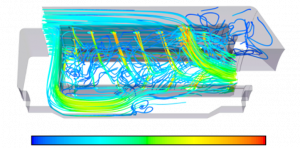
Fuel atomisation and vaporisation in a micro turbojet vaporiser tube are numerically studied in this work. A typical micro turbojet vaporising system is modelled using a computational fluid dynamics-based approach at both design point and sub-idle conditions. A Kelvin-Helmholtz-Rayleigh-Taylor breakup model is used to describe the fuel atomisation, whereas a saturation pressure-based evaporation model accounts for the fuel vaporisation inside the vaporiser tube. Turbulence is in turn modelled using a particular implementation of the k-ω SST turbulence model. Since the vaporiser tube fuel drop size distribution determines the micro turbojet ignition capabilities, its characterization is considered paramount in this work. The main outcomes show that the fuel droplets Sauter mean diameter at sub-idle conditions is about seven times the one corresponding to design point power settings. This finding emphasizes the need of carefully assessing micro turbojets ignition capabilities at low power settings. Similar numerical approaches can be utilised for studying micro turbojets ignition characteristics at other challenging conditions such as altitude relight. Keywords: Fuel atomisation and vaporisation, Computational fluid dynamics, Micro turbojets.
Autor(es):DELORD, Clement
GAUTHIER, Pierre
Snedden, G.
CELIS, Cesar
SETHI, Vishal
PILIDIS, Pericles
Año: 2017
Título de la revista: 23rd ISABE (International Society of Air-breathing Engines) Conference
Ciudad: Manchester, UK
